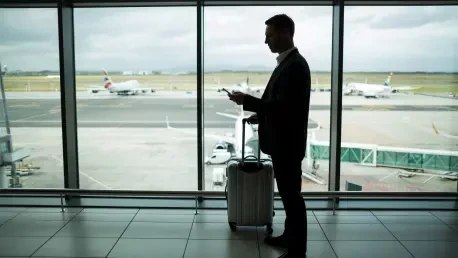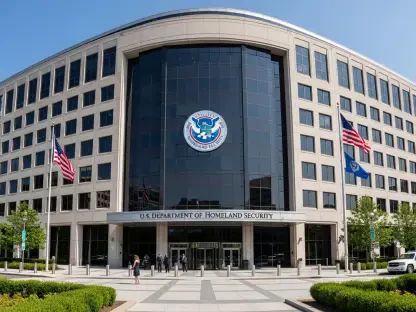The ripple effects of a prolonged government shutdown have brought the US air travel system to a grinding halt, with thousands of flights canceled and millions of passengers stranded amid growing uncertainty. As the shutdown stretches into its 40th day, the aviation sector is grappling with unprecedented challenges, from unpaid air traffic controllers to sweeping flight reductions mandated by federal authorities. This crisis, unfolding just ahead of the busy Thanksgiving holiday season, threatens to disrupt the plans of an estimated 80 million travelers. The intersection of political gridlock and public safety has sparked heated debates, with questions arising about whether the imposed restrictions are purely safety-driven or influenced by political motives. Amid this chaos, a tentative resolution in Congress offers a glimmer of hope, though the path to normalcy remains fraught with obstacles.
Unraveling the Aviation Crisis
The Scale of Flight Disruptions
The magnitude of the current crisis in US air travel is staggering, with over 3,300 flights canceled on a single Sunday, alongside delays impacting roughly 10,000 additional flights. Data from flight tracking services paints a grim picture of an industry under severe strain, as the Federal Aviation Administration (FAA) has been forced to implement phased reductions in air traffic to manage the situation. These cuts began with a modest 4 percent reduction in domestic flights, with plans to escalate to 10 percent in the coming days if conditions do not improve. The primary trigger for this drastic measure lies in the exhaustion and absenteeism among the 13,000 air traffic controllers who, despite being deemed essential, have been working without pay since the shutdown began. Their absence has created a dangerous bottleneck, compromising the safety and efficiency of the nation’s airspace, and leaving airlines with no choice but to ground flights at an alarming rate.
Impact on Holiday Travel Plans
As Thanksgiving approaches, the timing of this shutdown could not be worse for the millions of Americans preparing to travel. Historically, this holiday period sees record-breaking passenger screenings at airports, with numbers soaring year after year. The US Secretary of Transportation has issued a stark warning that air travel could “slow to a trickle” if the situation persists, casting a shadow over what is typically a peak season for the industry. Families and individuals face the daunting prospect of canceled flights or interminable delays, disrupting not only vacation plans but also critical business trips. The ripple effects extend beyond inconvenience, as airlines grapple with financial losses and passengers grow increasingly frustrated with a system that seems to be crumbling under political pressure. This holiday season, the joy of reunion may be replaced by the stress of uncertainty for countless travelers across the country.
Political Gridlock and Potential Solutions
Navigating the Funding Impasse
At the heart of this aviation turmoil lies a political standoff that has paralyzed government operations for weeks. A glimmer of hope emerged recently when senators reached a stopgap deal to fund government activities through January, potentially ending the shutdown. This compromise, achieved after a late-night Senate session with a decisive vote to break a filibuster, still faces significant hurdles before becoming law. Approval from both the Senate and the House of Representatives is required, followed by the President’s signature, which remains uncertain. Even if passed, the FAA has cautioned that reversing flight reductions will depend on safety data, meaning disruptions could linger. The delicate balance between political negotiations and the immediate needs of the aviation sector underscores the complexity of resolving a crisis that affects millions, with no guaranteed timeline for relief in sight.
Debating Safety Versus Strategy
Beyond the political maneuvering, a deeper debate has surfaced regarding the motivations behind the FAA’s flight restrictions. While officials assert that the capacity cuts are driven by data on controller fatigue and safety risks, some industry analysts question the transparency of these decisions. There is speculation that the severity of the measures might be influenced by a desire to pressure lawmakers into resolving the shutdown, rather than being solely based on operational necessities. Aviation experts argue that without clear communication from federal leaders, public trust in the system erodes, fueling suspicions of political gamesmanship. This tension between genuine safety concerns and potential strategic moves adds another layer of complexity to an already dire situation, as stakeholders from airlines to passengers seek clarity on how decisions are being made during this unprecedented crisis.
Reflecting on a Path Forward
Lessons from a Paralyzed System
Looking back, the government shutdown exposed critical vulnerabilities in the US air travel infrastructure, as unpaid essential workers like air traffic controllers bore the brunt of political inaction. The cancellation of thousands of flights and the delays that plagued countless others served as a stark reminder of how interconnected public services are to federal funding. The looming threat over the Thanksgiving travel period magnified public frustration, turning a logistical crisis into a deeply personal ordeal for millions. What became evident was the urgent need for mechanisms to shield critical sectors from the fallout of budgetary disputes, ensuring that safety and service do not become collateral damage in political battles.
Charting the Next Steps
Moving forward, addressing the aftermath of this shutdown demands a multifaceted approach to prevent similar crises. Lawmakers must prioritize contingency plans to protect essential services during funding disputes, potentially through emergency allocations for key personnel. The FAA should enhance transparency in its decision-making processes to rebuild trust among airlines and travelers alike. Additionally, investing in technology and training to bolster air traffic control resilience could mitigate future disruptions. As the nation reflects on this turbulent chapter, collaboration between government, industry, and analysts will be crucial to fortify the aviation system against the unpredictable winds of political gridlock, ensuring smoother skies ahead for all.









